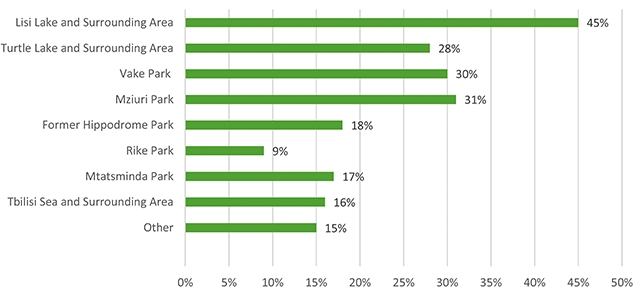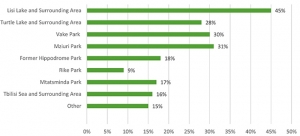Tbilisi Central Park Project – Call for More Green Space in the City
Pressure on environmental conditions has been increasing over the years in Tbilisi due to population increase: according to the National Statistics Office of Georgia (GeoStat), the capital’s population has increased by 8% over the last ten years; and the fact that Tbilisi is the center of Georgian business operations: GeoStat reveals that, by January 2020, 42% of economically active organizations were located in Tbilisi. These two factors are strongly associated with high levels of activity in the construction sector. According to GeoStat, 48% of construction permits issued in 2019 were allocated in Tbilisi. In many cases, construction projects are notably developing at the expense of city green space. Add to this the news that Tbilisi has the highest share of vehicle holders, with the Ministry of Internal Affairs of Georgia showing that 36% of registered vehicles are in Tbilisi.
Given the increasing pressure on the city’s environment, action should be taken to provide a healthier and more habitable space. The development of urban parks is therefore one viable option. However, the trend over the last decade has gone in exactly the opposite direction, with green space per capita decreasing dramatically. Estimations from Tbilisi City Hall data highlight that per-capita green space decreased from 5.6 to 1.3m2 between 2010-2018 (well below the average European standard of 10-15m2).
URBAN PARKS – A WIDELY SUPPORTED SOLUTION
The literature suggests that green spaces and nature-based solutions represent the most efficient approaches for improving quality of city life (World Health Organization, 2017). Urban parks, defined as delineated open space areas, mostly dominated by vegetation and water, and generally reserved for public use (Maruthaveeran, 2015), are considered an excellent method of expanding urban citizens’ exposure to nature. Historically, the primary role of urban parks has been to improve environmental conditions in cities by reducing urban heat, buffering noise, contributing to better air quality, and supporting ecological diversity. The significance of urban parks, however, is not limited solely to an environmental perspective.
Studies show that urban parks have a key role in supporting socialization and recreation among city residents, and this role has at times even grown to overshadow the environmental impact, with recreation being defined as an experience that results from freely chosen participation in physical, social, intellectual, creative and spiritual pursuits that enhance individual and community wellbeing (Elis, 2016). The international best practices of urban parks, such as New York Central Park, Boston Common, or Monsanto Forest Park in Lisbon, also reinforce that parks can become a key defining feature within a city. Regardless of the differences in their arrangement, a common characteristic of these parks is the diverse array of amusements for visitors, including gardens, museums, and attractions. Nevertheless, there is always plenty of green space and numerous leisure areas for friends and families to gather, and which attract daily visitors.
Although urban parks are considered valuable for their significant role in social development, they are not usually perceived as profitable investments: They require substantial capital and maintenance costs, which are usually never offset by financial revenue. Consequently, they are rarely an appealing investment opportunity for private investors. Thus, the majority of urban parks are provided by local governments as local public goods. Since local authorities are the main entities responsible for the provision, development, and management of urban parks, it is worth considering city residents’ preferences during the planning process.
URBAN PARKS IN TBILISI AND SOCIETAL NEEDS
The Mayor of Tbilisi recently presented a rehabilitation project for the former Hippodrome Park, aimed at transforming it into Tbilisi Central Park, which would thus increase the availability of recreational zones in the city. The suggested plan has, though, become a highly debated issue. While part of society is excited by the concept, others are strongly opposed to the plan. Most opponents believe that although rehabilitation is required, they fear that the development of a park in the direction suggested will remove its primary recreational function.
Consequently, in order to better examine local societal preferences, we designed a survey and shared it through social media. We asked respondents to offer their opinions on the proposed Tbilisi Central Park project, and on existing parks and green spaces in general. By the end of the exercise, we had collected the responses of 224 Tbilisi residents.
The survey results suggest that the existing parks are quite popular (40% of respondents visit parks and other green spaces several times a week). 93% of respondents claim that they would visit parks more often still if they had such spaces in the vicinity of their work or homes, whereas other respondents who reported that they would not frequently visit local parks said they believe there are already parks and green spaces close enough to their homes and work space.
The COVID-19 pandemic, and the related restrictions, have significantly increased utilization of public parks, and appreciation of this public good; 58% of respondents stated that during the pandemic, it has become more important to be able to visit green spaces. Nonetheless, only 24% reported managing to visit parks more often, largely because they had no access locally to such places. Finally, 99% of the individuals surveyed said they believe there is a need for more urban parks and green spaces in Tbilisi.
The respondents were also asked to evaluate the rehabilitation project of the former Hippodrome Park, attributing it a score between 1 to 10. Of the respondents, 52% evaluated the project between 1-5 (a negative evaluation), while the remaining 48% assessed between 6 and 10 (positive), confirming the split public opinion.
Examining the respondents’ answers in greater detail reveals that the main reasons for split public opinions are the characteristics of the suggested park. The new Tbilisi Central Park is expected to be divided into 26 different zones, including a food zone, an education center, alongside fountains and car parking zones. Thus, many of these “improvements” are likely at the expense of green areas, those currently used by residents for various recreational activities. This, however, is in stark contrast to the priorities highlighted by our respondents; with 61% claiming that the most urgent action should be increasing green space within the existing urban parks (i.e. grass, trees, etc.), followed by the need of multifunctional zones (28%), more space for sport activities (7%), and other basic comfort elements for visitors, such as the provision of drinking water and comfort stations (4%).
Local preferences are further confirmed by the fact that people tend to visit spaces with a greener environment (Graph 1), even if it is far from their living or working areas. Of those who usually visit greener spaces, such as Lisi Lake, the Hippodrome, Tbilisi Sea, etc., 39% state that, even though such places are not near their neighborhoods, they go because they enjoy the environment. Furthermore, most respondents who indicated other preferred locations (beyond the options provided), visit either small parks in their neighborhoods or forest parks, such as Dighomi and Krtsanisi Forest, which also confirms their inclination towards greener environments.
In summary, rehabilitation of the former hippodrome territory itself is a positive initiative. The main reason for any controversy seems to be that the planned infrastructural development does not necessarily meet societal needs or preferences. Our small survey suggests that any benefits could be magnified if the preferences of residents were better incorporated into the Central Park planning process; by minimizing the loss of green areas and preserving as much of the existing landscape as possible in order to maximize people’s exposure to the natural environment in the heart of Tbilisi.
By Mariam Chachava












